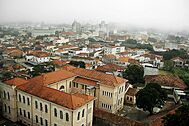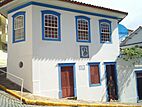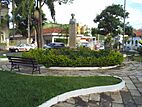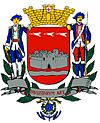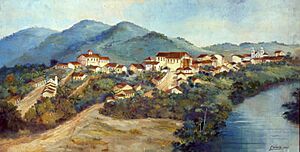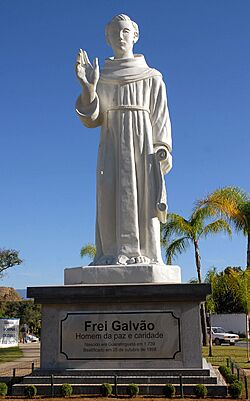Guaratinguetá facts for kids
Quick facts for kids
Guaratinguetá
|
|||
|---|---|---|---|
|
Municipality
|
|||
| Municipality of Guaratinguetá | |||
|
|
|||
|
|||
| Motto(s):
Paulistarum arx (Latin)
|
|||
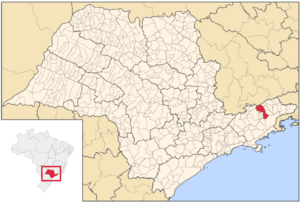
Location of Guaratinguetá in São Paulo state
|
|||
| Country | |||
| Region | Southeast Brazil | ||
| State | |||
| Metropolitan Region | Vale do Paraíba e Litoral Norte | ||
| Established | June 13, 1630 | ||
| Area | |||
| • Total | 752.64 km2 (290.60 sq mi) | ||
| Population
(2020)
|
|||
| • Total | 122,505 | ||
| • Density | 162.7671/km2 (421.565/sq mi) | ||
| HDI (2010) | 0.798 – high | ||
Guaratinguetá is a city in the state of São Paulo in Brazil. It is part of the Metropolitan Region of Vale do Paraíba e Litoral Norte. In 2020, about 122,505 people lived there. The city covers an area of 752.64 square kilometers.
Guaratinguetá is located in the Vale do Paraíba region. Some famous people from this area include Saint Frei Galvão, former Brazilian President Rodrigues Alves, and heart doctor Dr. Euryclides de Jesus Zerbini. The city's name comes from the Tupi language. It means "meeting of white herons." This is because gûyra means "heron," tinga means "white," and etá means "many."
The city is also home to part of the Mananciais do Rio Paraíba do Sul Environmental Protection Area. This large area was created in 1982. Its main goal is to protect the important sources of the Paraíba do Sul river.
Contents
A Look at Guaratinguetá's History
Early Days and First Settlers
Long ago, the local Indigenous people knew Guaratinguetá well. They knew it for the many herons living along the Paraíba do Sul river. The first Portuguese settlers arrived in the late 1500s. They came because of rumors about gold in the Serra da Mantiqueira mountains.
The area began to be settled in 1628. This happened when lands were given by Jacques Felix and his children. On June 13, 1630, people started building a chapel. This chapel was the first building recorded in the church's official book.
Becoming a Village and Trade Center
On February 13, 1651, a village was officially created. It was named Saint Antonio of Guaratinguetá. A main road was opened, and a traditional pillory (a public post for punishments) was set up.
During the 1700s, Guaratinguetá became a key supply point. It helped gold miners who came from Minas Gerais. Trade grew along this route. Many travelers from other countries visited the village. They wrote about it in books and showed it in paintings. The village's few narrow streets became busy on Sundays and holidays.
Religious Importance and Growth
Guaratinguetá gained more religious importance in 1717. In 1757, the city held a very big celebration for a saint. Diogo Antônio Feijó, who later became a priest and a leader of the Brazilian Empire, studied here. He lived in Guaratinguetá from 1795 to 1798.
In the 1800s, Guaratinguetá started growing a lot of coffee. At the same time, its sugar production went down. Brazil gained its independence during this time. On August 18, 1822, Dom Pedro I, the first emperor of Brazil, stayed overnight in the city. This visit helped the city's economy grow even more.
Coffee Boom and Modern Changes
The village officially became a city in 1844. It was fully recognized in 1852. During this time, coffee was very important, almost like money. The city's daily life changed a lot. More workers were needed on farms, and the city grew bigger. Farmers' children were sent away to study. Goods were brought by donkeys from the port of Parati, and trade increased.
Francisco de Paula Rodrigues Alves, born in 1848, was a very important person from Guaratinguetá. He served as a council member, a member of the Chamber of Deputies, and twice as President of Brazil.
In 1877, a railway was built, bringing more development. Immigrants came to work, replacing some of the manual labor. By the end of the 1800s, the city had a new theater, a metal bridge, a bank, a market, and a water supply system. It also got a sewer system and its first public school.
New Focus in the 20th Century
In the 1900s, the land became tired from too much farming. Coffee production started to decline. This led to a new economic focus: industrialization and a return to commerce.
Education also became very important. New schools were built, like the Escola de Especialista de Aeronáutica (School of Specialist of Aeronautics). A campus of UNESP with its College of Engineering and College of Technology (FATEC) was also established.
Tourism is now a big part of the city's economy. Many people visit because of the popularity of Frei Galvão. Visitors also enjoy the local caves, churches, and monasteries. The city has many old colonial houses with beautiful architecture. Agricultural tourism and Eco-Tourism are also becoming popular. This is because of the beautiful natural areas and farms around the city.
Getting Around: Transportation
The city has its own airport, called Edu Chaves Airport.
City Facts: Data
(Source: IBGE/ 2014 - IBGE)
- Total population: 118,378 people.
- Most people live in urban areas (109,012).
- Fewer people live in rural areas (9,366).
- There are more females (65,483) than males (52,895).
Staying Connected: Media
In the past, the city's phone services were provided by Telecomunicações de São Paulo. In 1998, this company was bought by Telefónica. Later, in 2012, Telefónica started using the Vivo brand. Today, Vivo provides cell phone services, landlines, internet (fiber optics and 4G), and television (satellite and cable) in Guaratinguetá.
See also
 In Spanish: Guaratinguetá para niños
In Spanish: Guaratinguetá para niños


